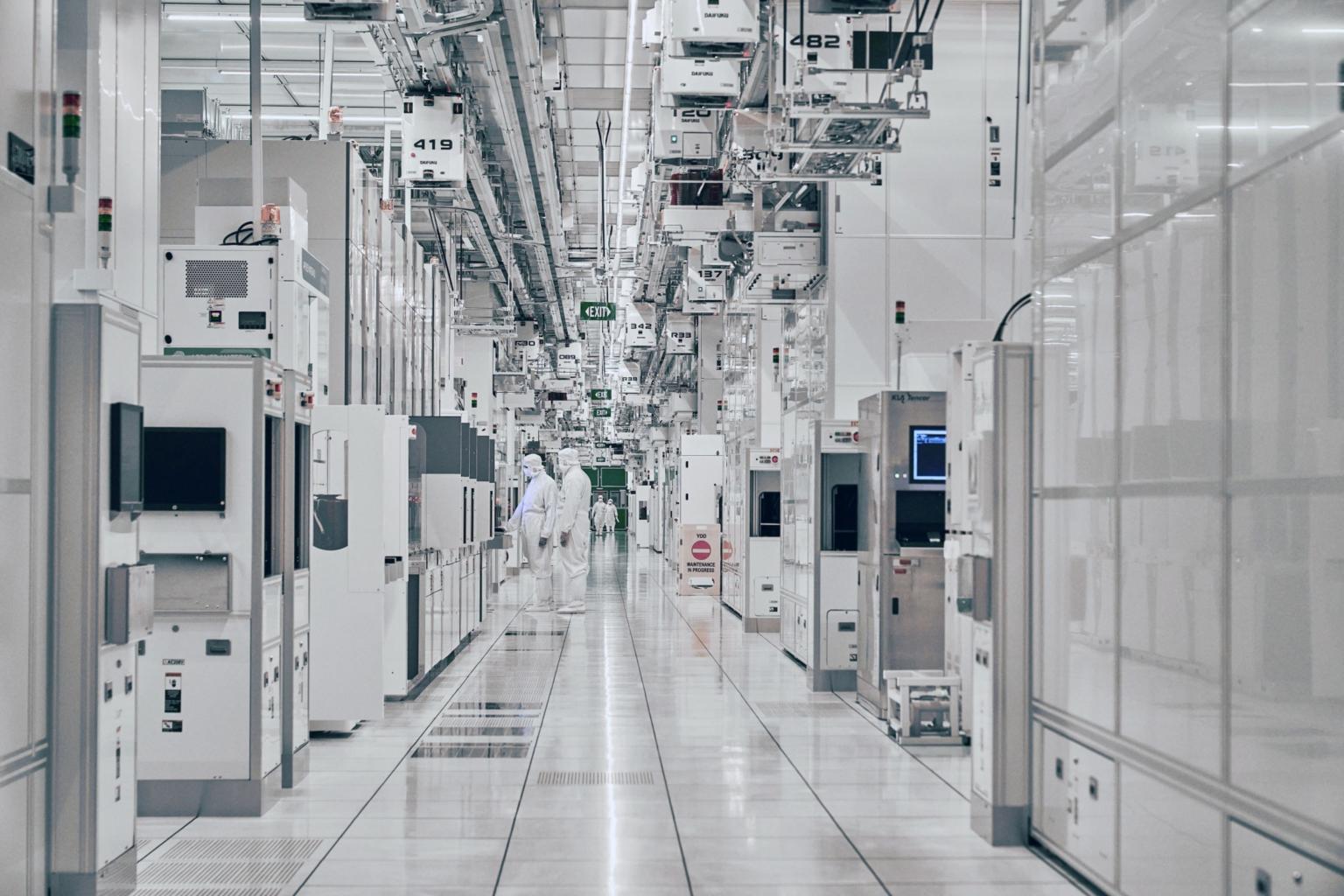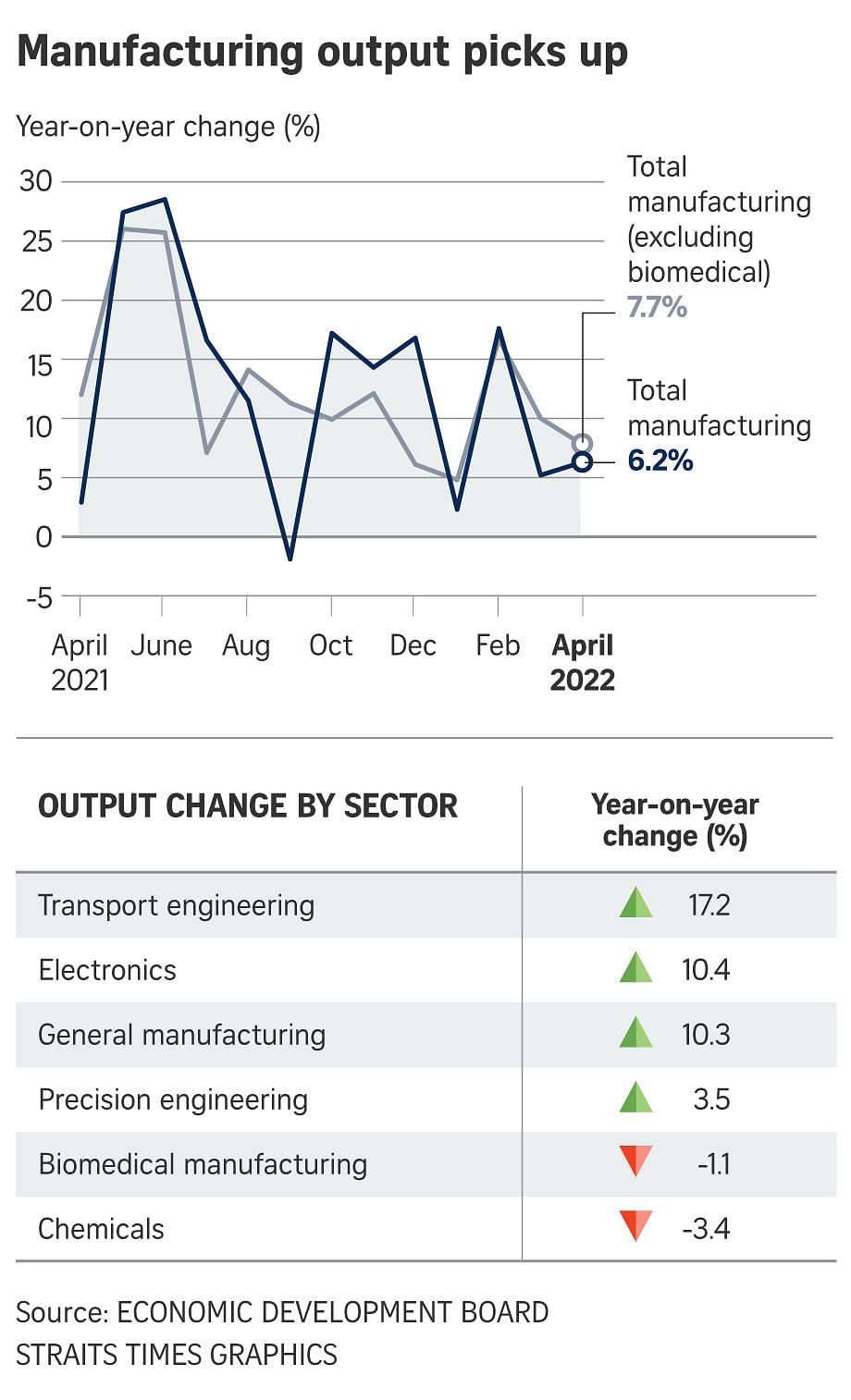Singapore factory output growth picks up in April on strong chip, aerospace demand
Sign up now: Get ST's newsletters delivered to your inbox

Singapore's manufacturing performance was lifted by the key electronics cluster.
PHOTO: BLOOMBERG
Follow topic:
SINGAPORE - Singapore's manufacturing output expanded in April for the seventh straight month, owing to strong demand for semiconductors and growth in the aerospace segment as travel restrictions are lifted globally.
Factory output rose 6.2 per cent in April on a year-on-year basis, data from the Economic Development Board (EDB) showed on Thursday (May 26), at a faster pace than the revised 5.1 per cent growth recorded in March.
Excluding biomedical manufacturing, output grew 7.7 per cent last month.
But the growth outlook remains uncertain for Singapore’s factory output, analysts said.
The Ministry of Trade and Industry announced on Wednesday that the 2022 gross domestic product growth forecast for Singapore is still 3 per cent to 5 per cent, with growth likely to come in at the lower half of the forecast range.
In the first quarter of the year, the manufacturing sector expanded by 7.1 per cent year on year, extending the 15.5 per cent growth recorded in the previous quarter.
OCBC Bank chief economist Selena Ling said: “Given that the first four months have recorded healthy manufacturing output growth, even if manufacturing momentum tapers in the coming months, there may be a slight upside risk to our full-year 2022 manufacturing growth forecast of 3.8 per cent year on year.”
She noted that the manufacturing sector has been boosted by robust global chip demand and improved aerospace maintenance, repair and overhaul activities, thanks to a worldwide chip shortage and revenge travel - two factors that should remain in play in the coming months.
“Even the general manufacturing segment is benefiting from higher output of beverage products, milk products and animal feed, which have been seeing increased demand.”
Meanwhile, the biomedical sector has been underperforming, perhaps as demand for test kits wanes with more countries treating Covid-19 as endemic, Ms Ling said.
“However, I would prefer to wait for another one to two months of data for confirmation, since the China slowdown story in the second quarter and the global supply chain disruptions, partly attributable to the Russia-Ukraine conflict, as well as the aggressive monetary policy tightening by major central banks... are still in play,” she added.
JPMorgan analyst Ong Sin Beng said: “Looking slightly ahead, we expect manufacturing to slow given the easing in global capital spending, but this should be offset by the services recovery as mobility and travel improve further.”
Singapore's manufacturing performance was lifted by the key electronics cluster, where output grew 10.4 per cent in April year on year. It saw expansion across all segments except that for other electronic modules and components.
In particular, the semiconductors segment expanded 12.9 per cent on the back of strong demand from 5G markets and data centres amid the global chip shortage, EDB noted.
Overall, the electronics cluster grew 13.5 per cent in the first four months of 2022 compared with the same period last year.
The transport engineering cluster was April's best performer, with output jumping 17.2 per cent.
The aerospace segment, which had been hit by the pandemic over the last two years, surged 24.2 per cent with the higher production of aircraft parts and more maintenance, repair and overhaul jobs from commercial airlines due to the lifting of air travel restrictions globally.
The marine and offshore engineering segment increased 27.5 per cent, supported by a higher level of work done in offshore projects, EDB said.
Cumulatively, the transport engineering cluster increased 15.3 per cent for the period from January to April 2022 compared with the same period a year ago.
Output rose in general manufacturing by 10.3 per cent, with all segments recording an increase.
The food, beverages and tobacco segment expanded 12.4 per cent with higher output of beverage products, milk products and animal feed.
The miscellaneous industries segment grew by 8.3 per cent, recording higher production of construction-related products and wearing apparel, while the printing segment grew by 4.2 per cent.

In the first four months of this year, output of the general manufacturing industries cluster expanded 12.3 per cent compared with the same period in 2021.
Meanwhile, the precision engineering cluster also saw output expansion by 3.5 per cent. The precision modules and components segment increased 5.4 per cent with higher production of optical products as well as plastic and metal precision components, EDB said.
The machinery and systems segment grew 2.9 per cent on account of higher output of semiconductor foundry equipment and mechanical engineering work.
On a year-to-date basis, output of the precision engineering cluster grew 3.6 per cent.
In contrast, output of the biomedical manufacturing cluster fell by 1.1 per cent in April. The medical technology segment grew 12.6 per cent with higher demand for medical devices from the United States and European Union. But the pharmaceuticals segment contracted 11.3 per cent on account of a different mix of active pharmaceutical ingredients being produced.
Output of the biomedical manufacturing cluster declined 2.9 per cent compared with the same period a year ago.
Output also fell in the chemicals cluster by 3.4 per cent. The segments for other chemicals, petroleum and specialities grew due to the higher production of fragrances, refined petroleum products such as jet fuel, and mineral oil additives in the respective segments.
But the petrochemicals segment contracted 12.5 per cent on account of maintenance shutdowns in some plants and weak demand from the region, EDB said.
Overall, the chemicals cluster decreased 1.7 per cent year on year in the period from January to April 2022.

